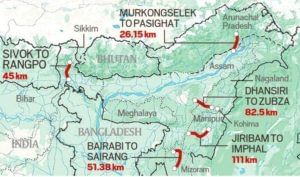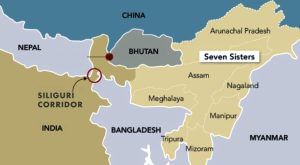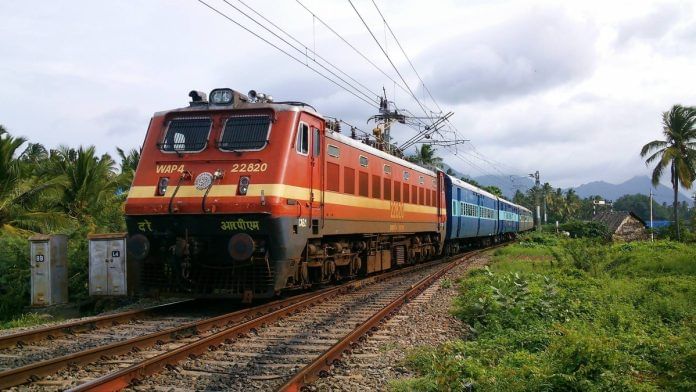Prime Minister Narendra Modi inaugurated the new Bairabi-Sairang railway line connecting Mizoram and Assam in September and flagged off three new railway services in Mizoram—Sairang-Delhi Rajdhani Express, Kolkata-Sairang Express, and Guwahati-Sairang Express. Aizawl is now “the fourth capital city in the Northeast to be connected” with India’s railway network — after Guwahati, Agartala, and Itanagar. By 2026, Kohima too will be connected with the Indian railway network, with the completion of Molvom-Pherima stretch in Nagaland, while the Jiribam-Imphal line in Manipur is likely to be operational by 2028.
The Indian government has portrayed the new railway projects as a game-changer for Northeast connectivity and national security. This narrative highlights efforts to reduce the vulnerability of the Siliguri Corridor and to counter adverse foreign policy trends such as deepening Bangladesh-China ties.
However, such claims tend to overstate the projects’ actual impact and overlook persistent operational and geopolitical challenges.

Siliguri Corridor
Several news articles mention that India’s target of connecting all eight Northeastern capitals by rail reduces its reliance on the Siliguri Corridor. Known as the “Chicken’s neck”, the Siliguri Corridor is a narrow 20-22 km strip of land in West Bengal, which serves as the sole terrestrial connection between mainland India and its eight Northeastern states. The corridor is geographically wedged between Nepal to the west, Bhutan to the north, and Bangladesh to the South, and serves as the primary route for providing essential rail, road, and defence connectivity to the Northeast. For the Indian forces, rail links through the corridor provide vital access to the Line of Actual Control (LAC). Apart from military mobilisation, this corridor facilitates “95 per cent of exports from Assam, Meghalaya, Manipur, Nagaland, and Arunachal Pradesh.”
Moreover, the corridor is in close proximity to Chumbi Valley in Tibet, where China has been expanding its military presence. China is reportedly helping Bangladesh in reviving the Lalmonirhat airbase, a facility just 12 to 20 kilometres from the Indian border and about 135 kilometres from the Siliguri Corridor. If the corridor were ever severed due to hostile activities or infrastructure disruptions, India’s Northeast states could be cut off from the rest of the country.
While India’s strategic vulnerability at the Siliguri Corridor has been accentuated since the Doklam standoff in 2017, the efforts to establish effective alternative routes have been limited and fraught with challenges. For instance, the Bairabi-Sairang line is also underway for a proposed 223-kilometre extension from Sairang to Hbicchuah near the Myanmar border.
Complementing this, the Kaladan Multimodal Transit Transport Project (KMTTP) provides an alternative route that bypasses the Siliguri Corridor. Under this project, goods travel by sea from Kolkata to Sittwe port in Myanmar (around 540 kilometres), then by river to Paletwa and by road into Mizoram. Once in Mizoram, goods can be connected to Aizawl and other parts of the state via the Bairabi-Sairang railway line. However, the viability of KMTTP remains in question due to implementation delays, escalating costs, and Myanmar’s ongoing political crisis.
Also read: Wakhan Corridor — India’s forgotten 106-km border with Afghanistan is back in play
Reality check—what the hype misses
The harsh reality is that such railway projects do not actually solve the fundamental problem of the Chicken’s Neck. To reduce dependency on Siliguri, India needs to accelerate the development of alternative connectivity routes. Nonetheless, most proposed alternatives depend heavily on transit through Bangladesh, such as Agartala-Akhaura Rail Link, Bhutan-Bodoland-Bay of Bengal (B3) Corridor (for port access), and Hili-Mahendraganj Corridor, among others.
Hence, Bangladesh remains critical to any viable strategy for offsetting Northeast India’s dependency on the Siliguri Corridor, which makes sustaining stable diplomatic relations with Dhaka essential for regional connectivity.
The culminating railway initiatives are often portrayed as decisive, nimble, and impactful responses to India’s worsening security threat matrix. In reality, the railway projects have been more than three decades in the making, conceived long before the “chicken neck” problem became a policy concern, while being incapable of resolving the same on their own and also reflect deeper challenges in project design, planning, and execution.

Operational challenges
Railway projects in Northeast India, which accelerated in the 1990s, were driven by counterinsurgency imperatives and the urgency to assert control over a region wracked by armed separatist movements. Nonetheless, these projects have become a case study for poor planning, engineering overreach, and overpromising. For example, the Mizoram capital link, proposed in the late 1990s, approved a decade later, and started in 2014, exemplifies the long delays typical of these projects.
Delays in Northeast railway projects stem from flawed planning and alignment choice, with the 1994 Railway Board prioritising rapid finalisation solely based on topographic data, ignoring geological and hydrological surveys. This resulted in unstable routes, excessive tunnelling, and oversized bridges, inflating costs and maintenance risks.
Projects originally slated for five to six years have stretched into decades, with the Bairabi-Sairang line alone escalating from Rs 619 crore to an estimated Rs 8,200 crore, while other lines to Imphal, Kohima, and Gangtok remain incomplete and fall short of directly reaching their state capitals (Sairang is about 20 kilometre from Aizawl). Also, safety and environmental challenges persist, as lessons from landslide-prone lines like Lumding-Silchar were largely ignored, making the operations fragile in regions with 2,500-4,000 mm of annual rainfall. Moreover, trains on these lines have become slower than those of the century-old hill lines.
Also read: India showed how to handle Trump without succumbing to his tantrums. Modi must be complimented
Regional frictions
Furthermore, India is planning to strengthen its northeastern frontier by adding 500 kilometres of railway lines to improve access, logistics, and military readiness along borders with China, Bangladesh, Myanmar, and Bhutan. The $3.4 billion project is expected to be completed within four years. However, the operations remain contingent on the proposed plans’ actual implementation, which depends on securing timely approval and budgetary allocations. Given the region’s challenging terrain and the long gestation period of previous Northeast railway projects, such projects are likely to face significant delays.
Along with operational challenges, India also needs to take into account the crises in Myanmar, which comes in the plan of extending the Aizawl line by 223 km toward the Myanmar border to complement the Kaladan project. Myanmar’s connectivity routes face severe sustainability challenges due to the ongoing civil war, which has placed its Sittwe Port in question, with project timelines pushed to 2027 amid uncertainty about long-term viability.
Looking ahead
The next phase of Northeast rail development hinges on turning ambitious surveys and bilateral connectivity plans into functioning cross-border railway links. This, however, remains shaped by regional geopolitics, local unrest in border states, and infrastructure challenges.
With the integration of Northeast India still in process, India and Bhutan have announced an ambitious plan of linking both the country’s railway network, with one key connection at Fulbari near Siliguri, a hub linking India’s northeastern states with the rest of the country and the Bangladesh border. Through this, Bhutan will be able to access India’s northeast and Bangladeshi ports like Chittagong and Mongla. The two railway lines, the 69-kilometre Kokrajhar–Gelephu line and the 20-kilometre Banarhat-Samtse line, will connect Bhutan with the bordering states of Assam and West Bengal, respectively.
India’s plans to integrate Northeast via Bangladesh have already encountered political headwinds. The Agartala-Akhaura line, inaugurated in 2023, remains non-operational due to political uncertainty in Dhaka since August 2024. This underscores that bilateral agreements do not always outpace on-the-ground realities alone. More than ceremonial inaugurations, successful connectivity requires parallel progress on regional peace, streamlined operations, and robust bilateral coordination. Practically, it needs operationalising cross-border routes through Bangladesh, which offers the most feasible alternative to the constrained Siliguri Corridor, linking the Northeast to mainland India.
Such projects will certainly add to integration and commerce of the region, gains that may not be entirely proportionate to the effort and investment involved, but are nonetheless valuable and significant. However, the anticipated security and foreign policy gains (particularly those relating to the Chicken Neck vulnerability and persistent instability in ties with Dhaka and Myanmar) are much less likely, and represent a different kettle of fish.
Torunika Roy is a Research Assistant to the Korea Chair at the Council for Strategic and Defense Research (CSDR), New Delhi. She is pursuing a PhD in Korean Studies at the Centre for East Asian Studies, School of International Studies, Jawaharlal Nehru University, New Delhi.
(Edited by Saptak Datta)






